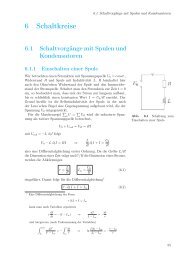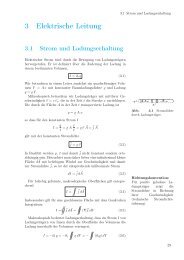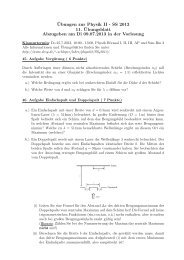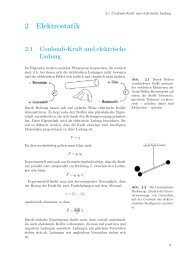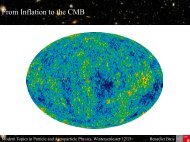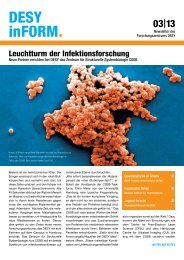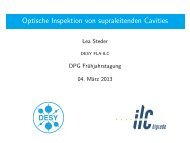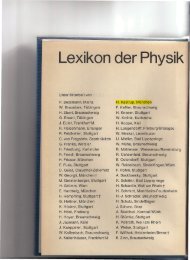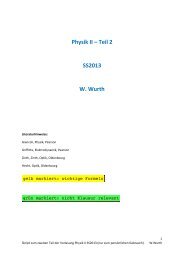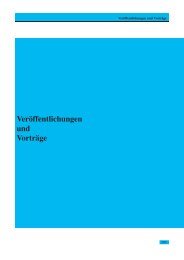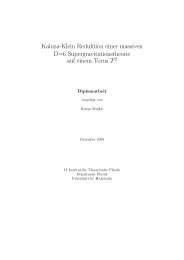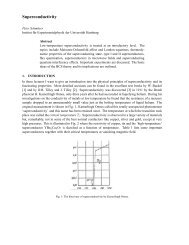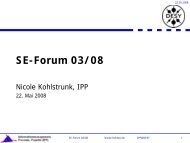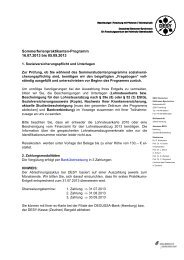Impuls- und Vernetzungsfonds Annual Report - Desy
Impuls- und Vernetzungsfonds Annual Report - Desy
Impuls- und Vernetzungsfonds Annual Report - Desy
You also want an ePaper? Increase the reach of your titles
YUMPU automatically turns print PDFs into web optimized ePapers that Google loves.
<strong>Annual</strong> <strong>Report</strong><br />
1 von 7<br />
<strong>Impuls</strong>- <strong>und</strong> <strong>Vernetzungsfonds</strong><br />
F<strong>und</strong>ing Programme: Helmholtz Young Investigators Groups<br />
Project ID No.: VH-NG-401<br />
Project Title:<br />
Group Leader: Dr. Katerina Lipka<br />
Helmholtz Centre: DESY<br />
Physics of gluons and heavy quarks from HERA to<br />
the LHC<br />
Participating University: Hamburg, Mainz, Wuppertal<br />
<strong>Report</strong> Period (=Calendar Year): 05/2011-04/2012<br />
1) Group Structure<br />
Please report briefly on the structure and personnel development of your group.<br />
Dr. Maria Aldaya<br />
Dr. Sebastian Naumann-Emme<br />
Dr. Krzystof Nowak<br />
Dr. Kadeer Alimujiang<br />
Dr. Ringaile Placakyte<br />
Monica Dobre (Ph.D. student, University of Hamburg)<br />
Jan Kieseler (Diploma student, University of Hamburg)<br />
Personel changes in 2011:<br />
- According to the planing of the YIG, Dr. Kadeer Alimujiang accomplished his work on the<br />
project and left in June 2011.<br />
- Dr. Sebastian Naumann-Emme joined the group in July 2011 in order to work on top quark<br />
production at CMS experiment.<br />
- Dr. Ringaile Placakyte joined the group in December 2011 (before associated member from<br />
Univ. Hamburg, BMBF Project 05H09GUF) to work on electroweak boson production at CMS<br />
experiment and PDF fitting tool development (in connection to the Sonderförderung Project S0-<br />
072)<br />
- Jan Kieseler joined the group as a Diploma student in March 2011. He submitted his thesis to<br />
the University of Hamburg on 01.03.2012.<br />
2) Network<br />
Please describe how you / your research group are integrated within the Helmholtz Centre and the<br />
partner university (e.g. as member of committees).<br />
The group is integrated in the High Energy Physics department of DESY in particular the H1<br />
and CMS groups, and contributes significantly to the research program of the Centre. Also, the<br />
close collaboration with the DESY Zeuthen theory department is established. The collaboration<br />
with the University of Hamburg is well established via common analyses in the CMS<br />
experiment and activities within the BMBF project 05H09GUF. The collaboration with<br />
University of Mainz is supported by the Forschungszentrum des Landes Rheinland-Pfalz<br />
“Elementarkräfte <strong>und</strong> Mathematische Gr<strong>und</strong>lagen”.<br />
3) Satisfaction<br />
How satisfied are you with the general working conditions provided by the Helmholtz Centre /<br />
partner university? Is there anything that meets your criticism?<br />
DESY offers the perfect infrastructure for international research. The support of the Centre and<br />
the partner universities corresponds to the cooperation contract.
4) Scientific Progress / Milestones<br />
How has your work plan progressed? Which important milestones could be achieved during the<br />
report period? Is the progress of your work in accordance with original planning or has the work plan<br />
been changed?<br />
The activities of the group are divided in several working packages where major milestones<br />
were achieved. In general, the progress of the group work is in accordance with original<br />
planning, however the working plan was significantly extended to follow the important spin-off<br />
activity, i.e. tool development for determination of the proton structure and inclusion of the LHC<br />
data into the measurement of parton distribution functions (PDFs). This topic is extensively<br />
treated in the inter-experimental project "Determination of the proton structure using deep<br />
inelastic scattering and proton-proton collisions " (Sonderförderung through HGF IFV, SO-072).<br />
Unless not stated otherwise, the described activities are initiated and lead by the members of<br />
the group.<br />
Progress on the working plan of the proposal.<br />
Role of the heavy flavour and jet measurements in the determination of parton density<br />
functions at HERA and impact on the cross section predictions for the LHC<br />
• The analysis of the deep inelastic charged current scattering at HERA with longitudinal<br />
electron (positron) polarisation in HERA-II running period is accomplished. Results will be<br />
published in 2012 together with measurements of neutral current cross sections and NLO<br />
QCD analysis of the two data sets. This measurement is the prerequisite for the ultimate<br />
PDF set from HERA, the HERAPDF2.0.<br />
• The work on the combination of the H1 and ZEUS measurement of charm quark crosssections<br />
is accomplished and entered the publication procedure. In addition to the<br />
experimental data on charm production, the publication includes the QCD analysis of this<br />
measurements and determination of the value of the charm quark mass, used as<br />
parameter in different phenomenological schemes. Also the influence on the predictions for<br />
W and Z-boson production cross section at the LHC is discussed. The preliminary results<br />
were reported in detail in the annual report 2010, the publication is expected in 2012.<br />
• The simultaneous extraction of the strong coupling constant αs(MZ) and of the parton<br />
density functions was performed at HERA, based on the inclusive measurements of deep<br />
inelastic scattering (DIS) and also including the jet measurements of H1 and ZEUS<br />
experiments. The extracted value of αs(MZ) is compatible with values obtained from<br />
different analyses of multi-jet production and the world average result.<br />
• The determination of PDFs using all available inclusive and semi-inclusive data sets at<br />
HERA was performed [1]. This investigation includes the combined HERA data on inclusive<br />
DIS, the data collected with lower proton beam energies, the combined charm<br />
measurements and the published jet measurements of H1 and ZEUS. The different data<br />
sets, included in the QCD analysis simultaneously for the first time, are sensitive to<br />
different aspects of the proton structure and test different aspects of the related<br />
phenomenology. The determination of αs(MZ) and of charm quark mass parameter in<br />
different heavy flavour schemes was performed. The analysis supports the results based<br />
on separately tested charm and jet data and strengthens the conclusions from [2] and [3].<br />
The resulting PDF, HERAPDF 1.7 [1], constitutes an important milestone for the ultimate<br />
PDF set from HERA, HERAPDF 2.0.<br />
Tool development for determination of PDFs in hadron-induced interactions<br />
The group contributed significantly to a joint H1-ZEUS project providing an open source tool,<br />
which can be used for determination of PDFs, HERAFitter. The HERAFitter program provides<br />
2 von 7
the opportunity to experimentalists (in particular the LHC experiments) to study the effect of<br />
different measurements on the PDFs even on an early stage of the analysis, using different<br />
theoretical schemes. HERAFitter is successfully used in ATLAS and CMS collaborations. The<br />
development of HERAFitter has its origin in the HERAPDF group and is meanwhile supported<br />
by developers from the H1, ZEUS, ATLAS and CMS experiments and several QCD theory<br />
groups. Several major developers of the HERAFitter tool are members of the group (R.<br />
Placakyte, K. Nowak, S. Naumann-Emme) or are supported via the S0-72 project (V. Radescu,<br />
P. Starovoitov).<br />
The first version of the HERAFitter has been made public in September 2011 [4]. The stable<br />
release is planned for 2012 along with the HERAPDF 2.0 publication. The group contributes to<br />
the stable release of the code through the implementation and validation of different heavy<br />
flavour schemes, providing the interface to PDF libraries and to the theory calculations of topquark<br />
pair production, implementation of the new data sets and documentation.<br />
Phenomenology of charm production in DIS at HERA<br />
In close collaboration with the DESY Zeuthen theory group (ABM), the work on determination<br />
of the running charm quark mass using charm production measurement and the QCD<br />
calculation at NNLO calculation performed. This is the first measurement of running charm<br />
quark mass in DIS using the charm production data. The result is in good agreement with the<br />
world average and has competitive precision. The analysis is based on the measurement of<br />
D*-meson production cross-section, published by the H1 collaboration in 2011. The result is<br />
presented at the Deep Inelastic Scattering Workshop (DIS2012) [5]. The analysis at NLO QCD<br />
is being finalized.<br />
Top quark physics at the CMS and Top-Quark related physics case investigation for the<br />
Phase1 upgrade of the CMS detector<br />
The group is consolidating itself in a leading position in the Top Physics Analysis Group of the<br />
CMS experiment and works together with the DESY CMS top quark group and the University<br />
of Hamburg.<br />
• Together with DESY CMS Top Group, we pioneered the LHC measurement of the topquark<br />
pair differential cross sections at √s = 7 TeV. The top-quark pair production is<br />
identified via top-quark decays with leptons in the final state. The cross sections are<br />
determined as a function of the kinematics of leptons, and top (antitop) quarks. The<br />
measurement has been performed in close collaboration with the group of Hamburg<br />
University and Korean groups and is published in the CMS publication [6]. Currently, the<br />
group is working towards the publication of the results with the full dataset, collected by the<br />
CMS experiment in 2011, corresponding to the integrated luminosity of 5 fb -1 [7].<br />
• The inclusive cross section of top pair production with electrons and muons in the final<br />
state has been measured [8] and fo<strong>und</strong> to be consistent with the QCD predictions at<br />
approximate NNLO, providing an important cross-check for the earlier published CMS<br />
result [CMS-PAS-TOP-11-005].<br />
• The cross section ratio of the top-quark pair to Z-boson production was performed, using<br />
the decay channels with muons and electrons in the final state. The complete data set,<br />
collected by the CMS experiment in 2011 is used. The ratio is insensitive to the luminosity<br />
uncertainties and is investigated as an alternative method to determine the top-pair cross<br />
section, making use of the NNLO prediction of the Z-boson production. The obtained topquark<br />
pair cross section is in agreement with the SM predictions at approximate NNLO and<br />
with the earlier CMS result. This analysis has been the topic of a diploma thesis of J.<br />
Kieseler.<br />
3 von 7
• The paper "Measurement of the top-pair production cross section and the top quark mass<br />
in the di-lepton channel in pp collisions at 7 TeV", to which the group contributed with the<br />
inclusive cross section measurement (cross-check analysis) and the cross section ratio<br />
top-pair to Z (main analysis) in the muon channel, has been published [9].<br />
• The pole mass and running mass of the top quark was determined for the first time at the<br />
CMS experiment [10] by comparing the top-quark pair cross section measurement to<br />
different approximate NNLO predictions. This approach allows obtaining the top quark<br />
mass in an unambiguous definition, while the direct measurements so far always rely<br />
heavily on less-well defined top-quark masses from Monte Carlo simulations. The results<br />
are in very good agreement with similar measurements by the Tevatron experiments and<br />
ATLAS.<br />
• Top-pair production at the LHC probes the range of high proton momentum fractions x of<br />
interacting partons. The PDFs in this x-range is poorly constrained so far using the data of<br />
HERA and Tevatron. Therefore, top-pair production at the LHC can help constraining the<br />
gluon density at high x. Studies on PDF constraints from measured top-quark pair cross<br />
sections are performed. The interface to the NNLO calculation through program Hathor into<br />
the HERAFitter is implemented, allowing for comparisons between data and predictions for<br />
the inclusive top-pair cross section at approximate NNLO. First study on the PDFdependence<br />
of differential cross sections using NLO predictions.<br />
• Within the SLHC Tracker Simulation Group, and in collaboration with the DESY CMS<br />
group, the group has continued investigating the tracking, vertexing and b-tagging<br />
performance of the "Phase 1" upgraded pixel detector, both in the High-Level Trigger (HLT)<br />
and in the full CMS tracker [11]. Significantly improved simulations of the behaviour of the<br />
front-end electronics have been performed. As a result, options for further improvement of<br />
the Phase 1 tracking software and algorithms, developed by the group, have been<br />
identified and are being worked on.<br />
5) Financial Plan / Time Schedule<br />
Can you comply with the financial plan and time schedule or do you see a need for adjustment?<br />
The expenses for personel and travel, including the CMS operation fees correspond to<br />
financial plan of the proposal. It is the great interest of the group to extend it’s involvement in<br />
the physics case study of the CMS Phase-1 upgrade to active contribution in the assembling<br />
and testing the modules of the new pixel detector. Therefore the group is applying for the<br />
additional investment from the president’s fond.<br />
6) Status<br />
Do you hold a joint Junior Professorship or a W2/W3 Professorship? Do you aim for such a<br />
position? What is the status of your negotiations in this respect?<br />
The group leader position was tenured by DESY on 01.05.2011 after the evaluation in April<br />
2011. There are no ongoing negotiations with the university of Hamburg and the group leader<br />
in connection to the HGF-NG-401. The group leader applies for professorships on a regular<br />
basis.<br />
7) Teaching Activities of the Group Leader<br />
Sommersemester 2011 Lecture/Seminars “Protons at highest energy: QCD and physics at the<br />
LHC”, shared with Dr. Isabell Melzer-Pellmann<br />
8) Publications of the Group<br />
Public Presentations by the group members<br />
• M. Aldaya, "Recent Top Quark Physics Results from CMS", XXVI Rencontres de Physique<br />
4 von 7
de la vallee d'Aoste, 26 Feb - 3 Mar 2012, La Tuile (Italy)<br />
• M. Aldaya, "Highlights of CMS Physics Results at 7 TeV", DESY seminar, 13-14 Dec<br />
2011, Hamburg-Zeuthen (Germany)<br />
• M. Aldaya, "Determination of the Top Quark Mass from the ttbar Cross Section at 7 TeV"<br />
(poster), Hadron Collider Physics Symposium, 14-18 Nov 2011, Paris (France), CR-2012-<br />
014<br />
• M. Aldaya, "Determination of the Top Quark Mass from the ttbar Cross Section at 7 TeV",<br />
(poster), 4th International Workshop on Top Quark Physics, 25-30 Sep 2011, Sant Feliu de<br />
Guixols (Spain), CR-2012-013<br />
• M. Aldaya, "Recent Results on Top Quark Physics at CMS", 23rd Rencontres de Blois on<br />
Particle Physics and Cosmology, 29 May - 3 Jun 2011, Blois (France)<br />
• J. Kieseler, "Measurement of the cross section ratio ttbar/Z in the ee and µµ final states at<br />
7 TeV with the CMS experiment", 5th <strong>Annual</strong> Workshop of the Helmholtz Alliance "Physics<br />
at the Terascale", 7-9 Dec 2011, Bonn (Germany)<br />
• J. Kieseler, "Measurement of the cross section ratio ttbar/Z in the ee and µµ final states at<br />
7 TeV with the CMS experiment", Spring Meeting of the German Physical Society (DPG<br />
2012), 27 Feb - 2 Mar 2012, Göttingen (Germany)<br />
• K. Lipka, “From PDFs and Heavy Quarks at HERA to the LHC”, DESY Seminar Feb. 2011<br />
• K. Lipka, “Proton structure measurements and PDFs at HERA”, Ringberg workshop on new<br />
trends in HERA Physics, Lake Tegernsee, 25-28 Sept. 2011, proceedings to be published<br />
in Nuclear Physics B Proceedings Supplement<br />
• K. Lipka, “Recent results from HERA and their impact for LHC”, Hadron Collider Physics<br />
Symposium 2011, Nov. 2011, Paris, proceedings http://arxiv.org/abs/1201.4486<br />
• K. Lipka, “Proton structure from DIS and the impact of the LHC data”, invited talk, 5th<br />
<strong>Annual</strong> Workshop of the Helmholtz Alliance "Physics at the Terascale", Dec. 2011, Bonn<br />
• S. Naumann-Emme, "Top-Quark Analyses in DCMS", summary talk, FSP-CMS <strong>Annual</strong><br />
Meeting, Karlsruhe, Sept. 2011<br />
• S. Naumann-Emme, "Top-Quark Measurements at the LHC", 3rd LC-Forum Meeting,<br />
DESY Hamburg, Feb. 2012<br />
• K. Nowak, "QCD analysis with determination of strong coupling based on HERA inclusive<br />
and jet data", XIX International Workshop on Deep-Inelastic Scattering and Related<br />
Subjects (DIS 2011), 11-15 April 2011<br />
• K. Nowak, "QCD measurements with jets and strong coupling determination at HERA",<br />
International Conference on the Structure and Interactions of the Photon and 19th<br />
International Workshop on Photon-Photon Collisions, 22-27 May 2011, Spa, Belgium<br />
• K. Nowak, “Summary of the Hadronic Final State working group”, summary talk at XX<br />
International Workshop on Deep-Inelastic Scattering and Related Subjects (DIS 2012), 26-<br />
30 March 2012<br />
• R. Placakyte, "Parton Distribution Functions, Uncertainties and Constraints", DPG-Tagung,<br />
March 29 2011, Karlsruhe, invited talk<br />
• R. Placakyte, "QCD Analysis of the Combined H1 and ZEUS F2cc Data and the Impact on<br />
the Z, W Cross Section Predictions at the LHC", Workshops on Deep-Inelastic Scattering<br />
and Related Subjects (DIS), April 2011, proceedings<br />
• R. Placakyte, "Parton Distribution Functions", XXXI Physics in Collision, Vancouver,<br />
Canada, Aug 28-1st Sep 2011; talk + proceedings (arXiv:1111.5452):<br />
• R. Placakyte, "HERAfitter project", presentation on CMS General Weekly Meeting,<br />
12.10.2011<br />
Publications<br />
[1] A. Cooper-Sarkar, K. Nowak, The NLO QCD analysis of inclusive, charm and jet data from<br />
HERA (HERAPDF1.7), H1prelim-11-143, ZEUS-prel-11-010<br />
[2] A. Cooper-Sarkar, K. Nowak “QCD analysis and determination of αs using the combined<br />
H1 and ZEUS NC and CC cross sections and the jet production cross section measured by the<br />
H1 and the ZEUS experiments”, H1-prelim-11-034, ZEUS-prel-11-001.<br />
5 von 7
[3] A. Cooper-Sarkar, S. Glazov, K. Lipka, R. Placakyte, V. Radescu “The Role of the<br />
Charm Mass Parameter in the QCD Analysis of the Combined HERA Data and<br />
Implications for the LHC”, H1-prelim-10-143, ZEUS-prel-10-019.<br />
[4] [H1 and ZEUS Collaborations] HERAFITTER, http://herafitter.hepforge.org/<br />
[5] S. Moch et al, presentation at XX International Workshop on Deep-Inelastic Scattering and<br />
Related Subjects (DIS 2012), 26-30 March 2012, proceedings to be published<br />
[6] The CMS Collaboration, "Measurement of top quark pair differential cross sections at 7<br />
TeV", CMS-PAS-TOP-11-013<br />
[7] M.Aldaya et al, "Measurement of Top Quark Pair Differential Cross Sections in the Dilepton<br />
Final State", CMS-AN-2012-065, in preparation<br />
[8] M. Aldaya et al, "Measurement of Top Quark Pair Differential Cross Sections in the Di-<br />
Lepton Final State at sqrt(s) = 7 TeV ", CMS-AN-2011-186<br />
[9] The CMS Collaboration, "Measurement of the ttbar production cross section and the top<br />
quark mass in the dilepton channel in pp collisions at sqrt(s) = 7 TeV", CMS-PAS-TOP-11-002,<br />
JHEP 07 (2011) 049<br />
[10] M. Aldaya, K. Lipka, S. Naumann-Emme, "Extraction of the Top Quark Mass from ttbar<br />
Cross Sections Measured by CMS at 7 TeV", AN-2011-359;<br />
The CMS Collaboration, "Determination of the Top Quark Mass from the ttbar Cross Section at<br />
7 TeV", CMS-PAS-TOP-11-008<br />
[11] M. Aldaya et al, "Simulation Studies of an Upgraded CMS Pixel Detector", IN-2011-017<br />
Theses<br />
J. Kieseler, “Measurement of the Top-Antitop and Z 0 -Boson production cross sections and their<br />
ratio in the dileptonic decay channels at √s=7 TeV with the CMS Experiment”. Diplomarbeit,<br />
submitted to the University of Hamburg on 01.03.2012.<br />
Responsibilities of the group members, organization of public events:<br />
• M. Aldaya: convenor of DESY CMS top-quark group, advising DESY Ph.D. students<br />
working in the DESY top-quark working group<br />
• K. Lipka: coordinator of HERA combination activity, convenor of HERA heavy flavour<br />
group, member of Program Advising Committee for the XX Workshop on Deep Inelastic<br />
Scattering and Related Subjects (DIS2012, Bonn), organisation of the CMS PDF Forum.<br />
• S. Naumann-Emme: software coordinator of the CMS Top Group, organizer of the<br />
workshop on Constrained Kinematic Fits in Events with Top Quarks at CMS, CERN,<br />
December 2011<br />
• K. Nowak: convenor of HERA jet combination group, convenor of H1 QCD/HFS group,<br />
convenor of the Working Group “Hadronic Final State” during the XX Workshop on Deep<br />
Inelastic Scattering and Related Subjects (DIS2012, Bonn)<br />
• R. Placakyte: convenor of the HERA Proton Structure group, convenor of the Working<br />
Group “Structure Functions”, during the XX Workshop on Deep Inelastic Scattering and<br />
Related Subjects (DIS2012, Bonn), organisation of the CMS PDF Forum.<br />
9) External F<strong>und</strong>ing<br />
6 von 7
10) Patent Applications<br />
11) Awards received by Group Members / Professorship Appointments offered to Group<br />
Leader<br />
7 von 7



